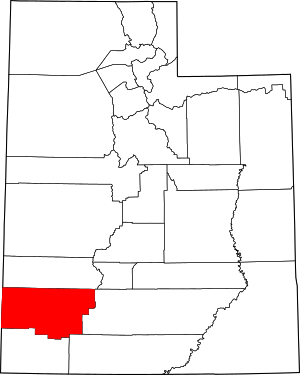Old Irontown, Utah
Old Irontown, Old Iron Town, or Irontown, originally Iron City, is an unincorporated community and near-ghost town in Iron County, Utah, United States.[2] It is located in Dixie National Forest, about 22 miles (35 km) from Cedar City. The settlement was founded in 1868 as a second attempt to mine iron from Iron Mountain after a disappointing yield from Cedar City. The colony lasted until 1876, when strife from the Edmunds–Tucker Act and the Panic of 1873 forced its closure. The site was added to the National Register of Historic Places in 1971.
Old Irontown, Utah | |
|---|---|
Unincorporated community | |
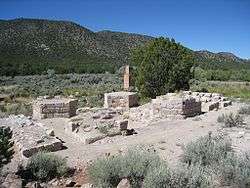 Ruins at Old Iron Town | |
| Nickname(s): Iron City | |
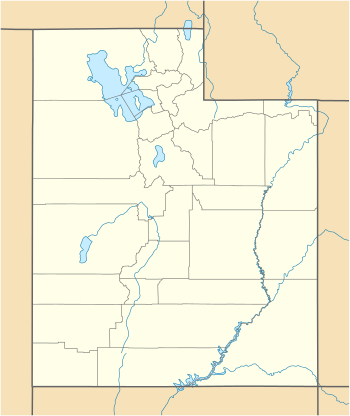 Old Irontown, Utah Location of Iron City in Utah  Old Irontown, Utah Old Irontown, Utah (the United States) | |
| Coordinates: 37°36′00″N 113°27′01″W | |
| Country | United States |
| State | Utah |
| County | Iron |
| Founded | 1868 |
| Abandoned | 1876 |
| Named for | Iron deposits |
| Elevation | 5,846 ft (1,782 m) |
| GNIS feature ID | 1444069[1] |
History
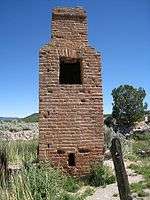
Brigham Young left Nauvoo, Illinois to establish Salt Lake City in 1847. Young quickly realized that the fastest way to an independent Mormon state was to make the new colony self-sufficient. One important resource in this regard was iron, which was very expensive to ship from the eastern United States.
The towns of Parowan and Cedar City were founded in 1851 to provide iron for the settlers, which was mined in the Iron Mountain District. Problems plagued the early furnace at Cedar City, and only about 25 short tons (23 t) of pig iron was produced over a three-year period. Iron was nonetheless needed for continued Mormon prosperity, so a second furnace at Old Irontown (Little Pinto) was made in 1868, using iron ore deposits at the southwestern base of Iron Mountain. By 1874, about 400 pounds (180 kg) of pig iron was produced, when operations ceased, and then abandoned 10 years later.[3]
At its peak, the settlement included a schoolhouse, blacksmith, charcoal furnaces, and a foundry. The city was abandoned in 1876. An attempt was made to revive mining from Iron Mountain, but the church was struggling with litigation over the Edmunds–Tucker Act and the Panic of 1873.
Today, the ruins feature a preserved beehive style charcoal oven and a furnace known as an "Arastra", which prepared sands for molds. Parts of the original foundry remain, including the chimney. The site was fenced off by the Sons of Utah Pioneers. It is currently within grounds designated as the Dixie National Forest. The Frontier Homestead State Park Museum in Cedar City provides information about and artifacts from the site. The ruins are found on Iron Town Road, which intersects with Utah State Route 56. The site was added to the National Register of Historic Places on May 14, 1971 as Old Iron Town. There are also a number of newer, occupied homes at the town's location.
See also
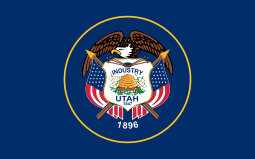
- List of ghost towns in Utah
References
- U.S. Geological Survey Geographic Names Information System: Old Irontown
- MyTopo Maps - Old Irontown, UT, United States (Map). Trimble Navigation, Ltd. Retrieved 30 Jul 2017.
- Mackin, J. (1968). Ridge, John (ed.). Iron Ore Deposits of the Iron Springs District, Southwestern Utah, in Ore deposits of the United States, 1933-1967. New York: The American Institute of Mining, Metallurgical, and Petroleum engineers, Inc. pp. 992–1019.
External links
![]()
